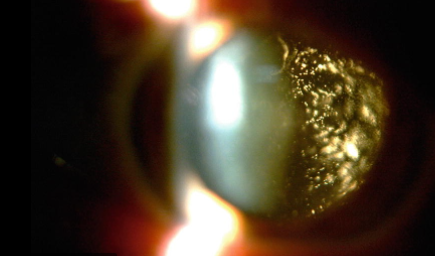Approximately 1 in every 200 people will be diagnosed with asteroid hyalosis during their lifetime.
Most people believe that if they have a problem with their eyes, they’d know it. Yet many people develop vision problems without even realizing it.
This is especially true in the case of an eye condition known as asteroid hyalosis, which typically doesn’t affect a person’s ability to see but yet still impacts eye health.
What is asteroid hyalosis?
Asteroid hyalosis (AH) is a degenerative eye condition marked by a buildup of calcium and fats, or lipids in the vitreous humor – the gel-like fluid between your eye’s retina and lens and makes up most of the volume of the eye. Other than genetics the most common cause of AH is diabetes.
Asteroid hyalosis appears as hundreds of tiny sparkling lights inside the eye.
What causes asteroid hyalosis?
While eye doctors most times are not exactly sure why lipids and calcium build up in the vitreous humor, it’s believed to occur alongside certain underlying conditions, including:
- Diabetes
- Heart disease
- High blood pressure
- High cholesterol
What are the symptoms of asteroid hyalosis?
The main symptom of AH is the presence of small white spots or floaters in your field of vision. These spots are often hard to notice unless you look very closely in bright lighting. For some, the spots might move, and usually don’t affect vision and for most, there are no symptoms at all.
If you’ve noticed small white spots in your vision, contact an eye doctor near you.
SEE RELATED: The 4 Frequent Eye Conditions
How is AH diagnosed?
Because of the calcium buildup in your eye caused by AH, your doctor will notice a white or sparkling lights inside your eye. AH will be confirmed with dilatation of your pupils and inspection of your eyes with a device called a slit lamp.
Your eye doctor may also have to scan your eyes using an optical coherence tomography (OCT). This allows them to better visualize the layers of the retina in the back of the eye.
How is AH treated?
AH doesn’t usually require treatment. However if it starts to affect your vision or you have an underlying condition that makes your eyes more vulnerable to damage, such as diabetic retinopathy, the vitreous humor can be surgically removed and replaced.
Despite the appearance of small white spots on your vision, AH is usually harmless. However, it’s important to continue to see your eye doctor for routine eye exams, especially if you have been diagnosed with diabetes or pre-diabetes.
LEARN MORE: Guide to Eye Conditions
If you notice any changes to your vision, schedule an eye exam with an eye doctor near you for a comprehensive eye examination.










